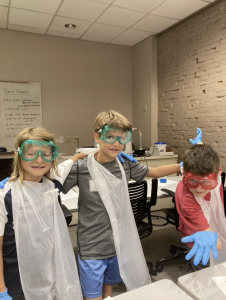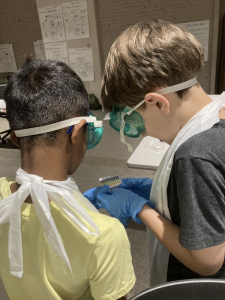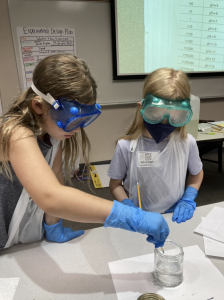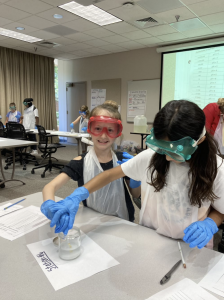Summer SAVY 2022/Session 4 – Chemical Spill for Rising 3rd/4th Grade
Friday: Good evening SAVY students and parents! The day began with a fun-filled opener of revealing to the students the unknown substances in each of the thirteen testing stations. Many students were surprised to discover the number of household items that were very acidic and/or contained a high dose of alkaline. The data results were analyzed and put into a data chart. Students learned how to graph the data and find the measures of central tendency (mean, median, mode, and range). The independent variable (liquid tested) was labeled on the x-axis while the dependent variable (pH Reading) was labeled on the y-axis.
In the afternoon, we designed an experiment that would allow us to determine the quantity of baking soda needed to neutralize an acid. Reviewing the results of Lesson 9 gave students a new idea about how to clean up the acid spill. Students discovered the fact that adding a base to an acid neutralizes the acid. Students worked in small groups to design a method for raising the pH of vinegar to 7 using the available materials. This experiment allowed us to make connections to how the crew at the scene of the accident could safely clean up the chemical spill without causing further damage.
It has been a joy to see the students learn so much about acids and bases in such a short amount of time. I love how they began to incorporate the system’s vocabulary terms learned as they provided facts/evidence to support their arguments. Thank you for allowing your students to be challenged and immersed in this academic experience.
Thursday: Good evening SAVY students and parents! Today was all about experimenting with acids and bases. Students were introduced to the pH scale and learned how to apply the pH scale in an experimental setting. The purpose of the pH indicators was explained as student’s watched a video about how to read the pH scale. Safety procedures for the lab activity were also discussed as students understood we would be working with unknown substance. Students geared up in their lab coats, gloves, and goggles to protect their skin, eyes, and clothing. Thirteen testing stations were setup with a sample of unknown chemicals. Each group visited every station to collect data about the pH of each substance. Important terms discussed include acidic solution, basic solution, neutralization, pH, pH neutral, and pH indicators. Tomorrow we will be analyzing the data and compiling the data to design a data table. We will also be learning how to neutralize an acid or a base by adding additional elements. I’m looking forward to an exciting, fun-filled last day of summer SAVY!
Wednesday: Good evening SAVY students and parents! Students were able to work in teams to reason through and complete their detour route. Acting as the supervisor of the Highway Patrol Department, students had to take into consideration how all stakeholders would be affected by the alternate route. Maps of a local community was provided for students to use as a model for developing their traffic detour route. Major roads, highways, communities, and landmarks were identified to assist people in getting safely away from the scene of the accident.
Questions asked to guide the student’s thinking included:
How does the input of corrosive liquid affect the entire creek system?
What might the Highway Patrol have to do?
Who should be informed about the problem? Why?
How do fumes coming from the water affect the surrounding area?
In the afternoon, we moved from re-routing the traffic into developing a method for identifying how much of the chemical was in the creek and how much time we have to keep the leaking chemical from contaminating the water in nearby homes. In our experiment, we designed a simulation that would allow us to analyze the potential relevance of spill and water flow to the problem. Key vocabulary terms included: constant, control, dependent variable, hypothesis, and independent variable. A rubber tubing was attached to the bottom of a funnel and the other end of the tubing was placed in a bucket. A stopwatch was set for five minutes as we put the funnel under a dripping faucet to collect water. The collected water was measured in graduated cylinders. The experiment was repeated several times, recording the volume of water collected each time.
Tomorrow, we will reflect on the identified variables in the experiment and discuss how this experiment can be used to determine the creek’s rate of flow. The simulated stream will also help us to determine the amount of time it takes for the creek to transport the chemicals. I’m looking forward to more hands-on experiences in tomorrow’s lesson.
Tuesday: Good evening SAVY students and parents! Today’s lesson started with a research-based method of retrieving data. Students wrote down two items that they remembered from yesterday and identified at least one system that can be found in our homes. Interest peaked when I presented the students with the Initial Problem Statement. The students are supervisors of the State Highway Patrol and received a 6:00 a.m. phone call to report to a major accident near Clear Creek Bridge on Route 15. Upon arrival, we find an overturned truck that has “Corrosive” written on a small sign on the rear of the truck. There is a huge gash in the side of the truck and from the gash a liquid is running down the side of the truck, onto the road, and down the hill into a creek. Steam is rising from the creek and all the traffic has been stopped. Police officers, firefighters, and rescue squad workers are at the scene all wearing coveralls and masks. The unconscious driver is on a stretcher. As the supervisor what do you do?
Students worked in a group to identify the relevant information within the problem statement. We discussed key words and phrases, systems within the problem statement, and resources that could help us to further investigate the issue. While we are investigating the scene, we come across a smudged invoice that leads to some further discoveries about the mysterious liquid running into the creek.
We’re running out of time and must prioritize a few tasks that will lead us to discovering the mysterious liquid…..
Questions we must answer:
*What is the mystery liquid?
*How much time before a possible explosion happens?
*Will the liquid in the creek affect the drinking water in the homes nearby?
*How can we identify an alternate route to get the traffic cleared before anyone is harmed?
I can’t wait to bring some items from the scene of the accident that will capture the student’s attention and allow us to conduct a few experiments that might reveal whether or not the liquid is harmful. Stay tuned….
Monday: Good evening SAVY students and parents! We are off to a great start learning all about systems and how they work. The concept of systems will be the basis of our scientific inquiry throughout this unit. Students were asked to draw the outline of a fish tank. Within their illustration students were asked to label all of the parts of their drawing. Volunteers shared their ideas as we discussed what things were contained in the fish tank and the items that are regularly put into and taken out of the fish tank. The relationship between the fish tank and a system was made by identifying the following parts: Elements, Boundaries, Inputs, Outputs, and Interactions. We used the fish tank model as an example for helping students to identify the parts of more complex systems that were recorded during our nature walk. Some more complex systems identified by the students included: Ecosystem, Transportation System, Educational System, and Security/Technology System. We will continue to use this information to identify generalizations about systems as we begin to conduct experiments and investigate real-world situations. I’m looking forward to another fun-filled day at summer SAVY!
Systems Design Poster (The Fish Tank)
Elements:
What are parts of the fish tank?
What is inside the fish tank?
What else has to be a part of the fish tank so that it does its job?
Boundaries:
What keeps the elements of the fish tank together?
What are the edges of the system?
Inputs:
What things go into the fish tank from the outside?
What are some things that have to be part of this system on a regular basis in order to maintain the system?
Outputs:
What things come out of the fish tank?
Interactions:
What are some of the things that happen in the fish tank to use the inputs and produce the outputs?
How does the fish tank use the inputs and give off outputs?




